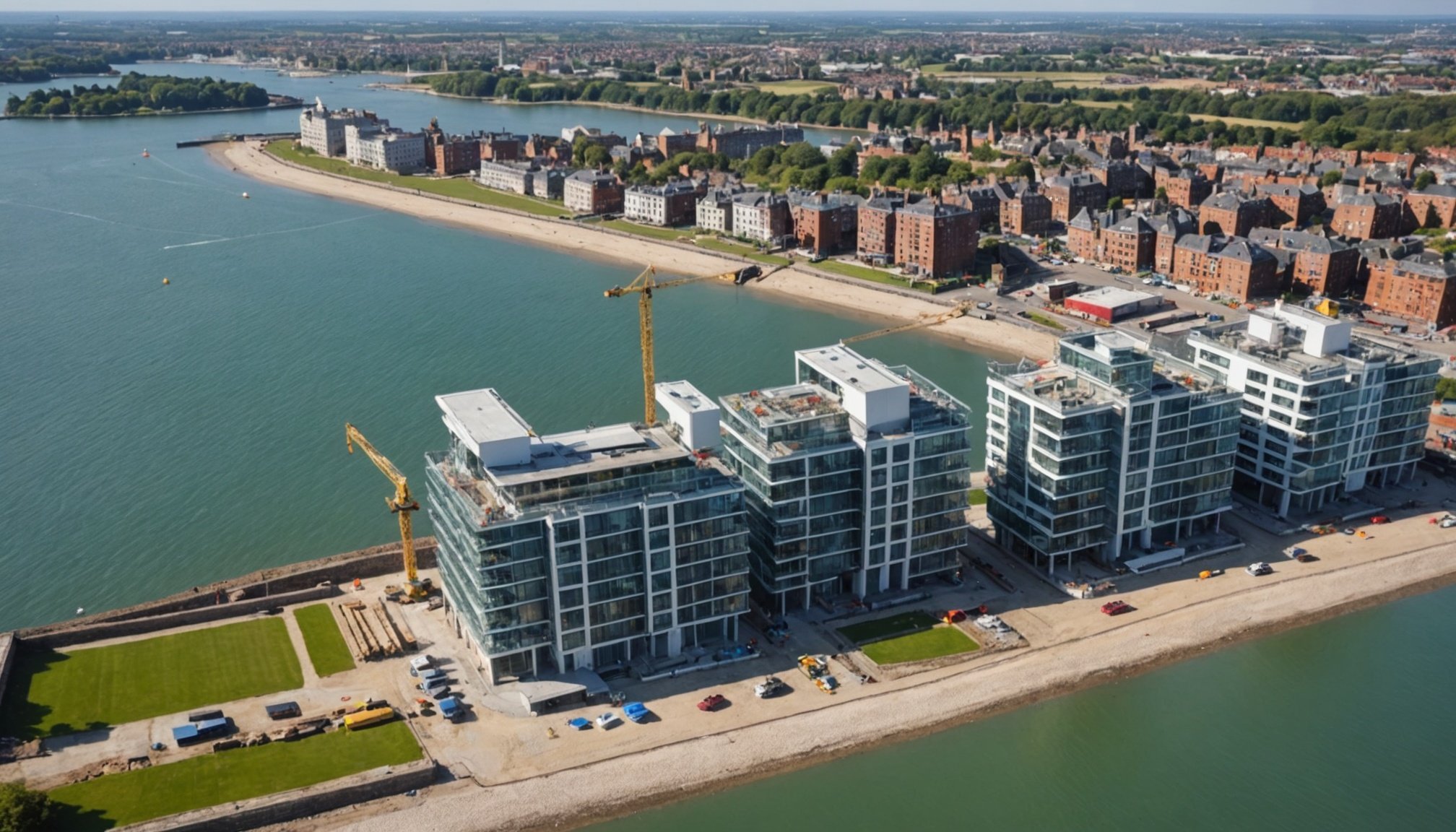Understanding Construction Loans for Waterfront Properties
Construction loans are an essential component of financing when building on waterfront properties. These short-term loans are specifically designed to fund the construction phase of a property project. Unlike traditional mortgages, they disburse funds in stages, typically aligned with the project’s development milestones.
Financing waterfront properties presents unique challenges. The allure of water-side living often comes with higher costs and additional regulatory requirements. For instance, acquiring permissions related to environmental considerations or flood risk assessments can complicate the financing process. Lenders may perceive these projects as higher risk, which might influence loan terms unfavourably.
Also to read : Essential Insurance Insights for Properties Next to York”s Historic Landmarks
Within the UK, current market trends are shaping the landscape of construction loans. As interest rates fluctuate, borrowers may find terms more stringent, especially when it comes to waterfront properties. Additionally, the demand for such prestigious properties often leads to competitive bidding, increasing property values and impacting financing strategies.
The distinctiveness of waterfront properties means lenders must carefully assess each project’s viability. Construction loans for these developments often integrate features such as interest-only payment structures during the build phase, transitioning to traditional mortgage arrangements upon completion. Understanding these elements and navigating the complexities can help ensure a successful project, keeping both the timeline and budget on track.
In parallel : Essential Guide: How to Safeguard Insurance for Your Grade II Listed Property in Wales
Key Influences on Property Valuation
Understanding property valuation is crucial, especially when dealing with waterfront property factors. The location of a property is paramount in market assessment, often dictating its value. Prime locations, such as those near water, command higher prices due to the exclusive access and stunning views they offer.
Waterfront property factors that impact value include privacy, direct water access, and potential for recreational activities. These unique features naturally make such properties more desirable, thus driving up their valuation. Unlike non-waterfront properties, which might rely more heavily on factors such as proximity to urban centers or transportation, waterfront properties possess innate characteristics that set them apart.
Additionally, during a market assessment, waterfront properties tend to be appraised at a premium due to their scarcity and unique lifestyle offerings. While non-waterfront properties might see their valuation fluctuate with economic trends, waterfront properties often retain their value more steadfastly because of enduring desirability.
Ultimately, understanding these influences can empower potential buyers or investors to make informed decisions. Recognizing what makes these valuations distinct can be a significant advantage in navigating the real estate market, providing better insight into what features to prioritize and the potential long-term value of a property.
Risk Assessment for Waterfront Properties
Risk assessment is critical in waterfront development, where unique challenges abound. Identifying potential risks is a vital first step in ensuring the success and safety of any project. Potential hazards often arise from environmental factors such as erosion, flooding, and storms. A thorough evaluation of these risks can inform construction risk strategies and help prevent costly setbacks or damages.
In the realm of waterfront development, environmental factors are significant influencers of risk. Construction risk is heightened in areas prone to natural disasters like hurricanes or heavy rainfall, which can cause flooding and erosion. Understanding the local climate and water patterns is crucial for accurate risk assessment. This can include studying historical weather records and predicting future climate changes which might impact construction and maintenance.
To mitigate risks effectively, several strategies are employed. Utilizing advanced materials and construction techniques can enhance the resilience of buildings against environmental threats. Incorporating natural barriers like dunes or mangroves can also help buffer properties from storm surge and erosion. Moreover, engineers and developers often work closely with environmental experts to design structures that are sensitive to and protective of their natural surroundings.
Comprehensive risk management ensures waterfront development projects are both sustainable and secure, safeguarding both investment and the environment.
Importance of Financial Stability
Understanding the role of financial stability in securing a loan is crucial for any potential borrower. Lenders meticulously assess financial stability as it directly impacts their decision-making process. At the core of this evaluation lies the borrower assessment, focusing on financial history and behaviours demonstrated over time.
Lenders employ specific criteria to measure financial stability, which typically includes credit score analysis, income verification, and checking existing liabilities. A comprehensive view of a borrower’s fiscal past helps in determining creditworthiness and risk propensity. Lenders are particularly keen on identifying consistent income streams and stable finances, as these elements foretell the applicant’s ability to handle repayments.
A significant part of this assessment involves a thorough examination of assets and cash flow. Assets serve as collateral, providing reassurance to lenders, while steady cash flow underscores the borrower’s ability to manage loan obligations seamlessly. Both factors are indispensable when lenders gauge the overall financial health of an applicant.
In summary, financial stability is not just an indicator of past behaviour but a predictor of future reliability. For anyone seeking a loan, maintaining a positive financial track record can be the key to meeting lender criteria and securing favourable terms.
Local Regulations Affecting Construction Loans
When contemplating a construction project in the UK, especially for waterfront property, understanding the intricate web of local regulations is crucial.
Firstly, UK construction laws specific to waterfront developments are designed to protect both the environment and property values. These laws can vary significantly depending on the locality, necessitating a thorough understanding of the specific rules that apply to your project site. You’ll need to acquaint yourself with local zoning laws and permits, which dictate the types of structures allowed and their possible uses. This process can be complex, often involving detailed applications and robust compliance assurances.
Moreover, environmental regulations play a pivotal role in determining project feasibility for waterfront properties. These laws are enforced to preserve natural habitats and ensure ecosystem sustainability. The propensity for flooding and the impact on marine life are key considerations that could affect your development. Consequently, securing a construction loan might require demonstrating compliance with such environmental statutes.
For streamlined navigation through these regulations, engaging with professionals familiar with waterfront property guidelines is advisable. They can provide insights into the permitting process, reducing the time to secure necessary approvals.
Understanding these local regulations not only safeguards your investment but also ensures the sustainable development of your chosen property.
Lender Criteria and Loan Options
In the context of UK construction loans, lenders evaluate applications based on a set of lender criteria designed to mitigate risk. This typically involves scrutinising the borrower’s creditworthiness, the viability of the construction project, and the applicant’s experience in similar undertakings. Lenders may look for strong financial profiles, robust business plans, and sometimes personal guarantees to approve a loan application.
Understanding these lender criteria is vital when exploring loan options. Various construction loans cater to different needs and stages of a project. For instance, bridge loans provide short-term funding to maintain cash flow until more permanent financing can be obtained. Construction-to-permanent loans convert to a mortgage post-construction, ensuring long-term stability. Furthermore, self-build loans focus on projects where the owner intends to personally oversee the construction process.
Choosing the right lender becomes especially crucial for projects like waterfront properties, which often involve additional complexities such as environmental regulations and increased land costs. It’s advisable to compare loan options from lenders known for handling similar properties effectively. This choice may affect not just the financial aspect but also the progress of the construction itself. Therefore, a well-researched decision plays a pivotal role in ensuring the success of such unique projects.
Analyzing Market Trends
The current market trends in the UK real estate sector are heavily influencing waterfront construction. As demand for scenic living spaces increases, the waterfront property market is experiencing a notable surge. Many developers are now prioritising eco-friendly designs and utilising cutting-edge technology to enhance these luxurious living options.
In the context of construction industry analysis, financial investments in sustainable infrastructure are becoming increasingly popular. Developers are incorporating renewable energy sources and resilient designs to combat environmental challenges. This not only boosts property value but also appeals to environmentally conscious buyers.
Looking towards the future, predictions suggest that waterfront property financing will continue to evolve. Banks and financial institutions are expected to offer more competitive mortgage rates and innovative financing solutions. This is likely to attract a broader range of investors, further propelling the growth of this niche market.
Consider the case study of the Thames Riverside Revitalisation project. This initiative exemplifies successful waterfront development by seamlessly integrating modern residential spaces with green public areas. Such examples demonstrate the potential for profitable, sustainable development in the waterfront sector.
As these trends and developments progress, it becomes critical for investors and developers to adapt their strategies. Aligning with these evolving market trends ensures competitiveness and long-term success in the UK real estate market, particularly within the coveted waterfront sector.
Practical Tips for Securing Construction Loans
When it comes to securing loans for waterfront projects, an effective loan application can make a significant difference. Start by assembling all necessary documentation, such as detailed project plans, financial statements, and cost estimates. It’s crucial to convey a clear vision and demonstrate your project’s viability.
To enhance your creditworthiness before applying, focus on improving your credit score. Paying down existing debts, ensuring bills are paid on time, and correcting any inaccuracies on your credit report are all effective financing tips. Lenders assess not only the project’s potential but also the borrower’s financial health.
Finding the best loan options involves using available resources strategically. Online comparison tools allow you to plug in your project specifics and explore what different lenders offer. Consult with financial advisors who specialize in construction loans to guide you through the application process. Additionally, local banks and credit unions often provide tailored loan packages for community-oriented developments.
The application process can be intricate, but thorough preparation greatly simplifies it. A robust application showcases preparedness and credibility which are invaluable in securing the necessary funding. Make sure to keep lines of communication open with potential lenders and seek feedback on how to enhance your application continually.
Real-Life Examples and Case Studies
Real-life financing examples provide invaluable insights into the complexities of property development. In the UK, several waterfront property success stories serve as benchmarks for developers. For instance, the prestigious Battersea Power Station project overcame immense challenges through meticulous financing strategies. Highlighting the financial endurance required, developers secured substantial construction loans by demonstrating robust feasibility studies and potential for high returns.
Conversely, not every development reaches such heights. Lessons from failed construction loan applications reveal the importance of comprehensive planning. Many failures stemmed from inadequate risk assessment or lack of proper documentation, highlighting the critical role of preparedness in financing.
Certain factors consistently contribute to successful financing outcomes. A key element is the clarity and detail of the development plan, ensuring it aligns with local regulations and market demand. Additionally, securing the trust of lenders often requires a track record of past successes or a strong financial backing.
In summary, while the path to financing success is fraught with challenges, learning from both triumphs and setbacks equips developers to navigate the intricate terrain of property development more effectively. Understanding these case studies empowers stakeholders to make informed decisions and enhance their prospects of securing necessary funding.











